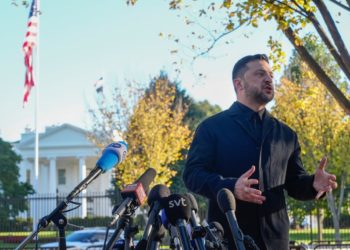When U.S. President Donald Trump and Russian President Vladimir Putin met in Anchorage, Alaska, on Aug. 15, Putin was greeted by a flyover of an American B-2 strategic bomber. Such flyovers can be a show of respect for a visiting statesperson, but Putin’s reptilian brain likely also registered fear as the stealthy aircraft roared overhead. He knows better than anyone that the world’s most advanced nuclear bomber could end his life within seconds.
This show of nuclear force followed closely on the heels of Trump’s order to reposition nuclear submarines to the “appropriate regions” in response to threats against the United States made by former Russian President Dmitry Medvedev.
Some analysts have criticized Trump’s nuclear saber-rattling as dangerous. But in fact, Trump can and should ramp up nuclear threats as part of a successful negotiation strategy to bring Russia’s war in Ukraine to an end.
Trump could threaten that the United States and NATO will have no choice but to strengthen their nuclear deterrent if the biggest war in Europe since World War II continues—but if the war were to end, Washington could reconsider these moves. This could include threats to develop and deploy additional U.S. nuclear weapons to Europe, pull out of the New Strategic Arms Reduction Treaty (New START), and build up the United States’ nuclear stockpile.
Many Western experts feel that sanctions are the most appropriate next step for turning up the pressure on Putin, and that is precisely why they will not work. Coercion is about getting into an enemy’s head and taking shocking steps that will knock them off balance.
Putin is most afraid of American nuclear weapons, and he will not like the prospect of having more of them arrayed at his doorstep. Indeed, he will be more affected by nuclear threats than the prospect of additional sanctions. After all, we have seen that Putin is perfectly happy to weaken the Russian economy in his bid to restore Moscow’s empire, but the prospect of being boxed in by American nuclear weapons is a direct threat to his imperial dreams in a way that sanctions simply are not.
To be effective, threats must also be paired with assurances, and Trump could make the timing and location of adjustments to the United States’ nuclear posture contingent on the outcome of the Ukraine talks. If peace in Europe is restored, Washington might have less need for a heavy forward nuclear presence.
Putin values and respects nuclear weapons as the last vestige of Russia’s erstwhile superpower status. In recent years, he has made nuclear weapons the center of Russian military strategy and has continually made nuclear threats in his standoff with the West over Ukraine.
Putin’s nuclear blackmail has worked. While in office, U.S. President Joe Biden repeatedly and publicly explained to the world that he significantly limited U.S. support to Ukraine because he feared that doing more might have triggered dangerous nuclear escalation with Russia.
Trump, in contrast, is less cautious and more willing to play nuclear brinkmanship with Putin as his recent shows of force demonstrate. Moreover, while Trump’s so-called madman persona has its downsides, it is actually a benefit in a game of nuclear chicken, because it makes the threat that things might actually spin out of control more credible.
Trump, therefore, can and should rely more heavily on this type of nuclear saber-rattling for two reasons. First, it could neutralize Putin’s attempts at nuclear blackmail. Russia’s war against Ukraine has been a game of nuclear chicken from the start, but only one side was playing. By fighting fire with fire, Trump can show that the West will not be intimidated by Putin’s nuclear threats.
Second, as Trump transitions to a pressure track in negotiations with Putin, nuclear threats—in addition to military aid to Ukraine and more sanctions—are a good way to turn up the heat and force Putin to negotiate in good faith. So far, Trump has attempted to ply Putin with carrots, but that approach has not produced the peace that Trump desires. Trump wants to stop the fighting, and the most likely acceptable outcome would be one in which the war ends roughly along the current line of contact, with Russia occupying parts of eastern Ukraine and Ukraine surviving as an independent state protected by Western security guarantees.
There are signs that Trump is getting impatient with Putin and may be willing to try pressuring him instead. In recent weeks, Trump has, for the first time, agreed to transfer U.S. weapons—paid for by Europe—to Ukraine. He has also announced or threatened to enact punishing tariffs or secondary sanctions on countries, such as China and India, that purchase Russian energy.
Trump has said that he may hold off on these tariffs for now as he hopes for a trilateral negotiation with Putin and Ukrainian President Volodymyr Zelensky. But in the likely event that those meetings do not produce a breakthrough, Trump will be looking for additional punitive measures again soon. When he does, the nuclear card should be on the table.
Here are three specific ideas.
First, Trump should threaten that if there is not an immediate end to the war in Ukraine, then he will have no choice but to deploy U.S. nuclear weapons to Poland and perhaps other front-line states on NATO’s eastern flank. The United States has deployed B-61 nuclear gravity bombs on the territory of several European NATO allies for many years, but their current locations in Western Europe do not make sense given the threat that Europe faces farther east. During the Cold War, U.S. nonstrategic nuclear weapons were positioned close to the front lines to deter Russia by making it clear that any invasion of NATO territory could go nuclear from the start. That same logic holds today. Accordingly, a bipartisan congressional commission (on which I was honored to serve) recommended that the United States develop and deploy additional nonstrategic nuclear weapons to Europe.
Second, for related reasons, the United States and NATO can announce their intention to deploy new varieties of nonstrategic nuclear weapons to Europe. The current B-61 gravity bombs require an aircraft to get close to a target, but given advanced Russian air defenses, there are real questions about this weapon’s future effectiveness. It would be much better to have a weapon with standoff capabilities. Trump and NATO leaders should announce a plan to upgrade U.S. nuclear weapons in Europe and expand NATO’s nuclear-sharing arrangements to include new types of nuclear air- and ground-launched cruise missiles.
Third, Trump should threaten to pull out of the New START agreement and load additional nuclear weapons onto U.S. strategic delivery platforms. The treaty expires in February 2026, and there is no follow-on deal in sight. Moreover, the aforementioned bipartisan commission recommended uploading additional nuclear warheads to deal with China’s growing nuclear stockpile. But, again, Trump could put this issue on the agenda in the Ukraine talks. If Putin is willing to end the war, Trump could reconsider remaining in the treaty and forestalling a U.S. nuclear buildup.
The United States will need to take some of these steps to update and fortify its nuclear posture regardless of the Russia-Ukraine war’s outcome. But Washington should at least benefit from the coercive leverage over Putin that these moves provide. The exact contours can be shaped through negotiations with NATO leaders and Putin.
Former U.S. President Dwight Eisenhower famously said, “If you can’t solve a problem, enlarge it.” Enlarging the Ukraine negotiations by playing the nuclear card may be the best way to help bring the war to an end and peace to Europe.
The post To Get Peace in Ukraine, Trump Should Play the Nuclear Card appeared first on Foreign Policy.




